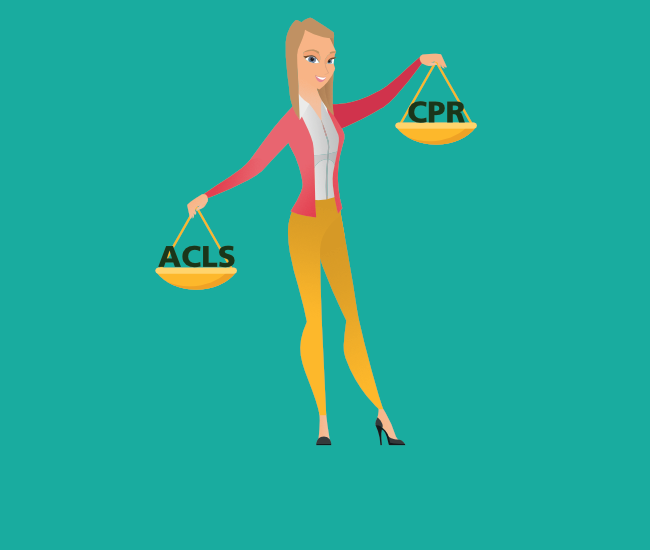Before we get into the differences between ACLS vs. BLS and ACLS certification vs. BLS certification, let’s begin by defining each. Otherwise, it would be like walking into a movie at the 20-minute mark, and we’d prefer to skip over any confusion.
What is BLS?
BLS stands for Basic Life Support. BLS involves a variety of life-saving skills and techniques, like CPR — a combination of chest compressions and rescue breaths — pulse checks, and rescue breaths without compressions. BLS also involves using specialized equipment like AEDs (Automatic External Defibrillators) and bag valve masks, just to name a couple.
BLS is performed mostly by healthcare professionals, like doctors, physicians, nurses, EMTs (Emergency Medical Technicians), paramedics, but also first responders like police officers and firefighters.
BLS is performed when patients are in cardiac arrest, respiratory arrest or distress, or when there is an obstructed airway. Besides the skills and techniques involved with BLS, other necessary skills like working well in a team environment, critical thinking, and problem-solving are all vitally important.
What is ACLS?
ACLS stands for Advanced Cardiovascular Life Support. In ACLS, healthcare professionals use a set of algorithms to treat conditions ranging from cardiac arrest and myocardial infarctions (heart attacks) to stroke and other life-threatening emergencies.
Part of ACLS involves healthcare professionals interpreting a patient’s heart rhythm using an electrocardiogram. Based on this heart rhythm, decisions are made regarding treatment options.
ACLS providers must have the skills and knowledge to place advanced airways and insert an IV (Intravenous) or IO (Intraosseous) line for the administration of fluids and medications. And they must have a thorough understanding of all the medications available to them that are used to treat for the variety of heart rhythms and conditions they will encounter.
Together, all of these ACLS skills and knowledge will be used to provide the best possible treatment that will allow for the best possible patient outcome.
What is BLS Certification?
As you may have guessed, BLS certification relates to the necessary training to perform basic life support functions. For healthcare professionals and first responders, this is a requirement of their jobs, but it’s also often a requirement for other professions like lifeguards, coaches, teachers, daycare workers, and nursing home employees.
During a BLS certification course, you’ll learn basic life-saving skills that can be applied when encountering a person who has stopped breathing or whose heart has stopped beating. It’ll be your job to revive, resuscitate, or sustain them until more advanced help arrives.
BLS certification courses can be taken in-person or online and usually take a few to several hours to complete. Well-known organizations that provide such courses are the American Red Cross and the American Heart Association (AHA), along with other professional medical training organizations.
A BLS certification is good for two years following the completion of a course. At that time, the recipient would need to be re-certified. Guidelines are always being updated and new techniques are often introduced, which makes re-certification important.
What is ACLS Certification?
Like BLS, ACLS certification is the process of learning the skills and techniques necessary to properly handle all advanced cardiovascular emergencies.
ACLS training will focus on the following:
- An understanding of BLS
- How to properly recognize and manage cardiac and respiratory arrest
- How to support and/or lead a resuscitation team
- Advanced airway management skills
- ACLS pharmacology
ACLS training is often a requirement for doctors, registered nurses (RNs), and paramedics. Providers of ACLS are often the last line of defense when it comes to those patients suffering from a cardiac or respiratory emergency.
Also like BLS certification, ACLS certification courses range from in-person classes to online courses. And ACLS certification is also valid for two years, at which time that certification must be renewed.
What is the Difference Between BLS and ACLS?
Congratulations!. We’ve finally arrived at our destination. If you’re anything like Scooby-Doo, and we don’t mean a talking cartoon canine, by now you’ve probably already figured out the difference between the two. And if you haven’t, let’s look again at the two acronyms and what they represent.
BLS — Basic Life Support
ACLS — Advanced Cardiovascular Life Support
In other words, basic vs. advanced. BLS, a term that is often interchangeable with CPR, is not always performed by healthcare professionals and often performed outside of a hospital environment.
ACLS, on the other hand, is specifically for healthcare professionals. The advanced aspect of ACLS demands a foundational understanding of medical knowledge, of which BLS is simply one part of.
The good news is that whether you’re looking for a BLS certification course or you are a healthcare professional seeking a more advanced ACLS certification course, ProTrainings is like one-stop shopping. Follow those links above for more specific information on each course. And don’t forget, while the courses are different, the objective remains the same: to save lives!

